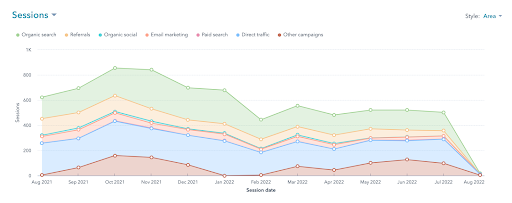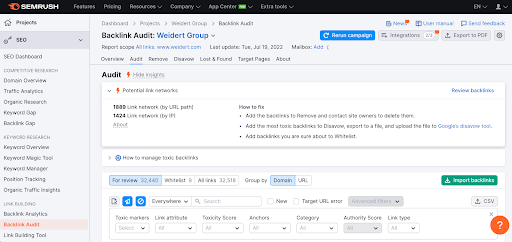Top 6 Ways to Increase Website Traffic After a Decline
Written by
While inbound marketing is an effective way to drive traffic to your website, it has its challenges. Among them is this:
You can surface a bazillion data points and still have a tough time determining cause and effect on certain key performance indicators.
This fact points back to that holistic quality of an inbound program, with numerous tactics working synergistically. Inbound works as a whole, and all the components are interconnected.
But if you’re experiencing a steep or sudden drop in website traffic or a longer, continued downward sessions trend, you’ll need to address the decline quickly.
Fortunately, you can take steps to identify root causes of a drop in website traffic. From there, you’ll know which actions are needed to correct issues and start bringing more visitors to your site.
In this article, we’ll walk through these six key areas to examine and address if you’re dealing with falling website traffic:
- Determine whether the traffic you are getting is actually valuable
- Identify the sources and timelines of declines in traffic
- Dig into those sources to find more specific data and identify root causes and contributing factors
- Determine strategies to improve performance by channel, and get to work
- Analyze competitors’ content — what’s driving traffic to their sites?
- Amplify your efforts by improving content promotion
Why is My Website Traffic Dropping?
Nothing about business, marketing, or the internet stays constant very long. Website traffic can feel like a moving target. You could have a new competitor in your industry, or a competitor that’s done a great job on a new and content-robust website. You might have technical issues wreaking havoc on user experience or web crawlers as they navigate your website content. And when was the last time you reviewed your backlink sources?
The good news is, if your website traffic is down, there are plenty of steps you can take to assess and improve your site. The other news is that you have to do the work to see the results. Here’s how to increase your website traffic, step by step.
1. Determine the Value of the Web Traffic You Lost
You can determine whether your lost website traffic had any marketing and sales value by asking these questions:
- Did the lost visitors come from countries where you actually do business?
- Are the rest of your funnel KPIs still strong, or are they falling, too?
If the rest of your funnel is still performing well, you can dig deeper using the next few steps to make sure your drop in traffic isn’t a leading indicator of a bigger website issue — but you don’t need to devote all your resources to it right away. Just keep a close eye on those KPIs, work toward improvements, and be ready to act fast if needed.
If the traffic lost was from countries you care about or your KPIs dropped too, fear not, that’s what the rest of this article is for!
2. Identify Sources and Timelines of Declines
Find out whether it’s your direct, organic, social, referrals, paid, or other sources seeing the steepest declines. If your biggest contributor to falling traffic is organic search, you’ll need to perform an audit of your content and backlink portfolios. (See the next section for how.)

3. Identify Root Causes & Contributing Factors
The next step is to figure out whether formerly prominent pages have experienced big drops, and learn as much as you can to start to get a lead on why. Look for pages that have slipped in SERP rankings, or that no longer rank for your high value keywords. Google Analytics is the place to start; Google Search Console and SEMrush are also among several useful tools we recommend.
Be sure to consider other factors, such as a change in publishing frequency or changes to your promotional channels. Use SEMrush to analyze year-over-year trends in search behavior to determine whether your primary, high-ranking keywords have dropped in overall search volume.
Have there been search algorithms updates or changes that correlate with your drop in traffic volume? Remember, when Google added Core Web Vitals in June of 2021, lots of websites saw steep drops, and site improvements helped address the issue.
Use SEMrush to perform a backlink audit. Are all links to your content relevant and coming from authoritative sources using specific anchor text? Have your backlinks drastically jumped in number? Review linking domains for quality, and be sure to bulk disavow any spammy domains.

4. Determine & Execute Improvement Strategies by Channel
Make a list of action steps you’ll want to take by each channel, taking a content–keyword–platform approach. Here’s an example of what we mean:
- If you’ve got previously high-performing content that’s slipped in ranking, or pages with technical SEO errors, prioritize and optimize those pages. Start with your web pages that slipped off page 1 of the SERP.
- If you’ve lost high-performing relevant keywords, identify which pages previously ranked for them, and optimize.
- If you lost an important backlink from a relevant, authoritative site that had been driving top-notch referral traffic (like an important industry association or trade publication), reach out and ask to have the link reinstated.
Now, get to work addressing technical SEO issues. Have you optimized for Core Web Vitals? Look for crawl errors, warnings, broken links, and issues with page speeds, and take care of any problems you find in those areas.
RELATED: How Google Core Web Vitals Will Change Your B2B Website (If You Let Them)
5. Identify and Address Competitors’ Content Advantages
Analyze your top competitors’ sites to see what content is working for them in high value keyword rankings, and compare against yours. Look for potential gaps in your content strategy — or whether they usurped your place because their content is newer or more robust. If that’s the case, get to work drafting updated and improved content following SEO best practices for content writing.
6. Tweak Your Content Promotion Strategy to Amplify Your Efforts
Paid ads on social media platforms can add a boost to help promote your key converting content, so you can improve not just traffic, but conversions, too.
Even more important, make sure your teams—marketing, sales, and customer service—are sharing your content! You might even think about partnering with key industry thought leaders and influencers to amplify your reach and get your content in front of relevant eyes.
Make the Best of the Bad News
It’s never welcome news to see a drop in the number of visitors to your company website, but regular monitoring can help you keep up-to-date with SEO best practices. Plus, regular updates and maintenance create opportunities to review content strategies and make constant, continuous improvements.
Your first order of business is surviving the drop, of course. But the learnings you can glean from your site data should help inform your content, keyword, and platform approaches to increase traffic moving forward. In fact, here’s an instant opportunity to get started. Our free, quick and easy website grader tool serves up a report card that includes critical site performance data, plus key recommendations for improvements. Click to get started and see how your site scores.
Subscribe To Our Blog
Information. Insights. Ideas. Get notified every time a new Weidert Group blog article is published – subscribe now!
You May Also Like...

Artificial Intelligence
Revenue-Driving B2B Content Marketing Strategy with Andy Crestodina

Artificial Intelligence
AI Agents Are Here—How Smart Businesses Are Using Them Now

Inbound Marketing
Podcasting Playbook: What We Learned After 100 Days of Running a B2B Podcast
Accelerate Your Growth with
Weidert Group
If you’re ready to explore a partnership, request a personalized consultation with our team.

